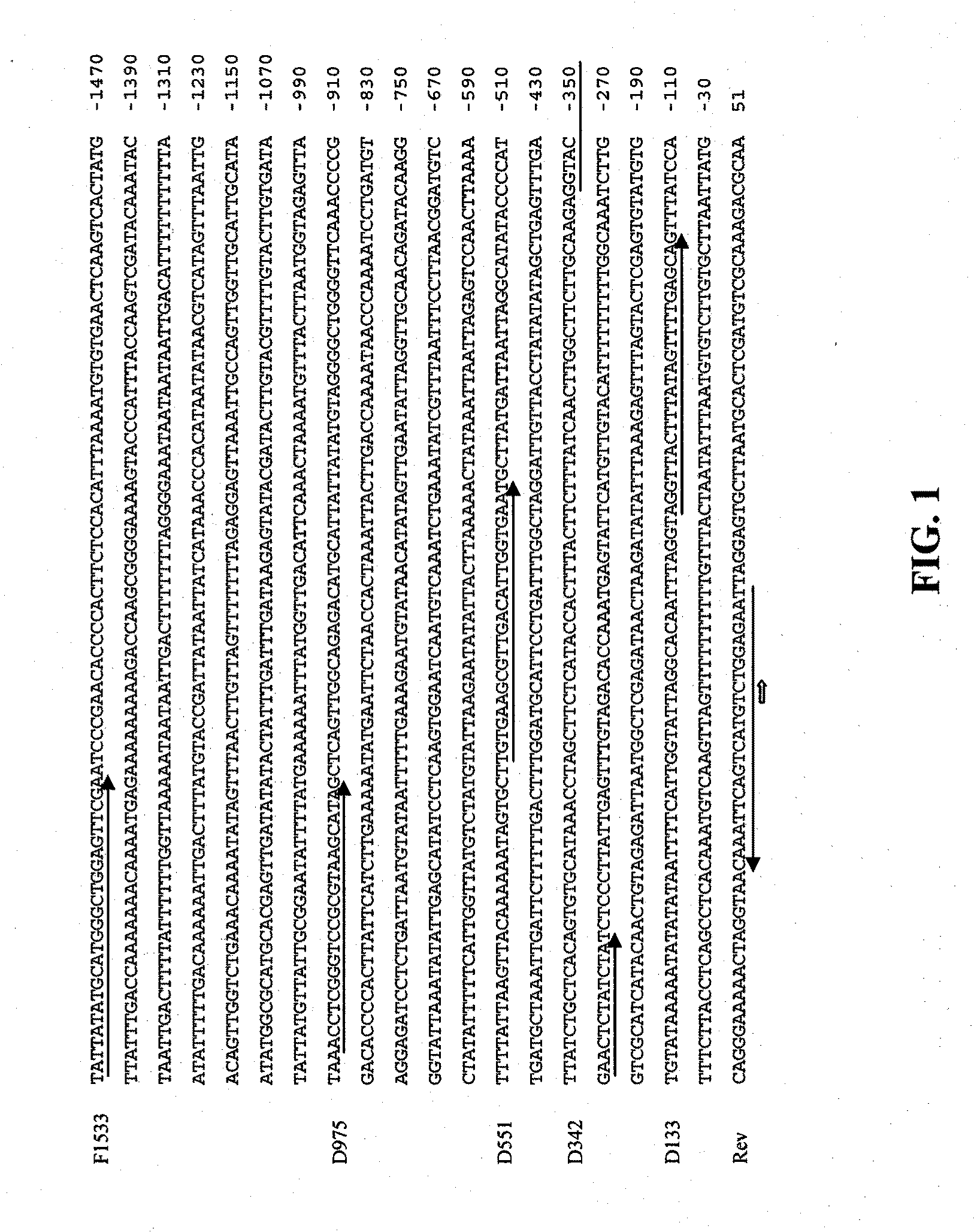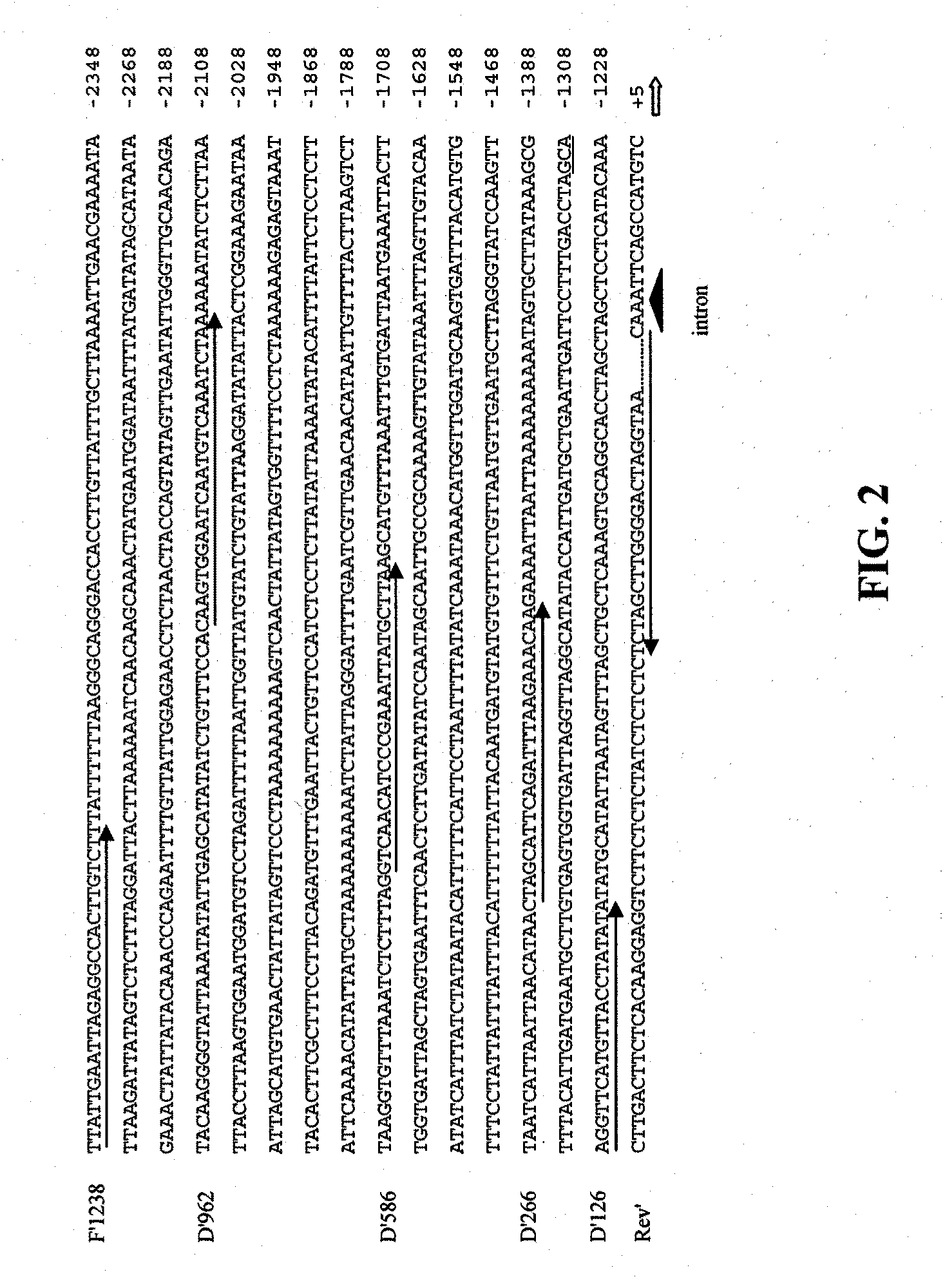Root-specific phosphate transporter promoters
a phosphate transporter and promoter technology, applied in the field of new regulatory sequences with defined tissue specificity, can solve the problems of general lack of appropriate regulatory elements, inability to provide tissue-specific or inducible expression, and inability to work constitutive promoters
- Summary
- Abstract
- Description
- Claims
- Application Information
AI Technical Summary
Benefits of technology
Problems solved by technology
Method used
Image
Examples
example 1
Isolation of MtPT1 MtPT2 and MtPT3 Promoters and the Construction of Chimeric Transgenes
[0148]For the isolation of MtPT1 promoter, the sequence information of MtPT1 cDNA (AF000354) was used to blast search genomic sequences of M. truncatula (www.genome.ou.edu / medicago.html), provided by the Advanced Center for Genome Technology of the University of Oklahoma (Roe and Kupfer, 2004). A contig containing the MtPT1 sequences was identified, and primers were designed to amplify M. truncatula genomic DNA to obtain 5′ sequences of MtPT1 (FIG. 1). The MtPT1 promoter region was PCR amplified using primers 5′ TATTATATGGATCCGCTGGAGTTC 3′ (forward) (SEQ ID NO:4) and 5′ CTCCAGCCATGGCTGAATTTGTT 3′ (reverse) (SEQ ID NO:5). The forward primer contained a BamHI restriction site (underlined), and the reverse primer had a NcoI restriction site (underlined). The amplified sequence was digested by BamHI and NcoI, and the fragment was isolated after gel electrophoresis. The isolated MtPT1 promoter fragmen...
example 2
Transgenic Expression of Reporter Genes Under the Control of MtPT1 MtPT2 and MtPT3 Promoters
[0151]A. Agrobacterium-Mediated Transformation
[0152]The five new promoter-reporter gene constructs created as described above: MtPT1-GUS, MtPT1-GFP, MtPT2-GUS, MtPT2-GFP and MtPT3-GUS (FIG. 4A-E), were used for generating transgenic Arabidopsis plants and for hairy root transformation of M. truncatula. DNA of the binary vectors was transferred into the Agrobacterium tumefaciens strain C58 by the freeze-thaw method (Chen et al., 1994). Transgenic Arabidopsis plants were generated following the floral dip protocol method (Clough and Bent, 1998). The binary vectors were also transferred into A. rhizogenes strain Arqual (Quandt et al., 1993) and used for hairy root transformation of M. truncatula following the procedure described by Boisson-Dernier et al., (Boisson-Dernier et al., 2001). Transgenic Arabidopsis plants and transformed hairy roots of M. truncatula were grown at 24° C. under fluoresc...
example 3
Deletion Analysis of MtPT1 and MtPT2 Promoters
[0164]To further characterize the MtPT1 promoter, a series of deletions of the promoter region were created by PCR using the primers D1 (5′ AGGTAGGATCCTTTATAGTTTTG 3′) (SEQ ID NO:8), D2 (5′ GCAAGAGGTAGGATCCCTATCTA 3′) (SEQ ID NO:9), D3 (5′ GCTTGTGGATCCTTGACATTGGT 3′) (SEQ ID NO: 10), D4 (5′ AACCTCGGATCCGCGTAAGCAT 3′) (SEQ ID NO: 1) at the 5′ end and Rev (5′ CTCCAGCCATGGCTGAATTTGTT 3′) (SEQ ID NO:12) at the 3′ end (FIG. 1). A BamHI restriction site was introduced in the forward primers, and a NcoI restriction site was introduced in the reverse primer. The shortened promoter sequences obtained after PCR amplification were digested by BamHI and NcoI, and were cloned into BamHI and NcoI digested binary vector CaMV35S-GUS to drive the GUS gene.
[0165]Similarly, a series of deletions of the MtPT2 promoter were created by PCR using the primers D1 (5′ GCAAGGATCCTGTTACCTATAT 3′) (SEQ ID NO:13), D2 (5′ ACTAGGATCCAGATTTAAGAAA3′) (SEQ ID NO: 14), D3 ...
PUM
| Property | Measurement | Unit |
|---|---|---|
| length | aaaaa | aaaaa |
| pH | aaaaa | aaaaa |
| pH | aaaaa | aaaaa |
Abstract
Description
Claims
Application Information
 Login to View More
Login to View More - R&D
- Intellectual Property
- Life Sciences
- Materials
- Tech Scout
- Unparalleled Data Quality
- Higher Quality Content
- 60% Fewer Hallucinations
Browse by: Latest US Patents, China's latest patents, Technical Efficacy Thesaurus, Application Domain, Technology Topic, Popular Technical Reports.
© 2025 PatSnap. All rights reserved.Legal|Privacy policy|Modern Slavery Act Transparency Statement|Sitemap|About US| Contact US: help@patsnap.com



